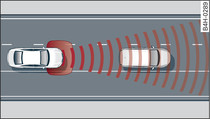
- Fig. 1 Sensor range
Applies to: vehicles with Audi adaptive cruise control
The adaptive cruise control is a combined speed and distance control system. It assists the driver by controlling the road speed and the distance to the vehicle in front within certain limits imposed by the system. The adaptive cruise control system can accelerate and brake when it detects a vehicle in front. This provides maximum comfort both on long motorway journeys and in congested traffic.
What can the adaptive cruise control do?
The adaptive cruise control uses video, radar and ultrasound. This allows the detection of vehicles up to 200 metres ahead.
When there is no traffic in front, the adaptive cruise control works just like a normal cruise control system by maintaining a constant speed. When you draw closer to a vehicle in front, the adaptive cruise control matches your speed to that vehicle by automatically applying the brakes, and then maintains a constant distance (which you can adjust in the settings). As soon as it detects no more vehicles in front, the adaptive cruise control accelerates back up to the cruising speed.
When you approach a corner, the adaptive cruise control reduces the vehicle speed based on the map information stored in the navigation system*. After the corner, it accelerates back up to the cruising speed1).
In congested traffic, the adaptive cruise control can brake down to a standstill and accelerate again under certain conditions ►Link.
Audi braking guard can warn you of impending collisions and can initiate the application of the brakes ►Link.
Which functions can the driver control?
When you switch on the adaptive cruise control, you can set your current speed as the "cruising speed" ►Link.
While you are driving, you can interrupt the cruise control ►Link or change the speed setting ►Link at any time.
In addition, you can adjust the distance to vehicles in front and the driving mode of the adaptive cruise control ►Link.
1) Not available on vehicles for some markets.